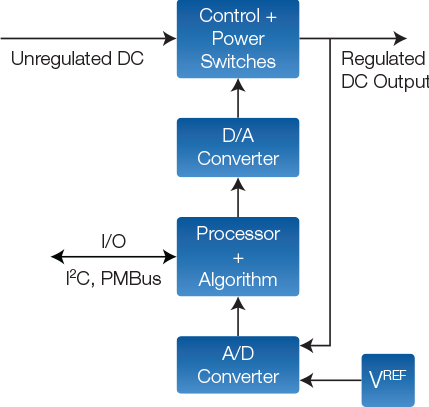Digital Power: All-Digital Control Loop Design and Benefits

by Bill Schweber for Mouser Electronics
A few years ago, "digital power" was mostly a concept with some prototypes under long-term evaluation, but few actual installations. Fast-forward to 2019, and you will see these supplies are now standard and essential in power-intensive applications such as data centers. This article explores digital power design and benefits
Digital Power Design
The objective of a power supply or converter is simple to state: Provide a stable, regulated DC output at the desired voltage value despite changes in input voltage or load conditions. This requires some form of closed-loop control within the DC/DC converter, based on measurement of the actual output voltage, comparison with the setpoint value, and feedback-based corrections to force the output back to the setpoint and keep it there.
Analog vs Digital Closed Loop Control
Analog Closed Loop Control
This regulation has traditionally been implemented using a closed-loop negative feedback with analog circuitry in a switching regulator (Figure 1). There are many standard architectures for these switchers with a long list of additional enhancements to increase efficiency across the entire load range, boost performance, and ensure consistent operation. These enhancements can become quite complicated and clever, and have impressive names such as single-ended primary-inductor converter (SEPIC).

Figure 1: The standard analog power converter uses the well-known closed-loop topology to maintain a regulated DC output despite changes in input and load. (Source: Author)
These variations can become fairly complicated and sophisticated, but all have one drawback: They lack flexibility for real-time setting of operational parameters. For example, the Intel® standard requires the ability to direct the supply to change its nominal output voltage from 1.2V to 0.9V and back “on the fly,” which an all-analog supply cannot do. This adaptive voltage scaling (AVS) adjusts the supply output voltage to the minimum required by the processor—depending on its clock speed and workload—and also compensates automatically for process and temperature variations within the processor. To do all this requires a fully programmable, sophisticated, firmware-controlled converter.
It is possible to implement some of the desired changes via an input/output (I/O) port on the supply coupled with digital parameter-setting circuitry. This results in a hybrid supply that has an inner analog-control loop, but overall digital supervision and some reporting of supply status (Figure 2).

Figure 2: The enhanced analog controller design retains the fundamental closed-loop design, but it allows for digital setting of some parameters under external control via a digital port such as PMBus, I2C, SPI, or other. (Source: Author)
Digital Closed-Loop Control
The all-digital supply uses a very different internal architecture. Rather than implement the control loop using analog circuitry, even with some digital oversight, the digital supply uses analog/digital (A/D) converters to digitize critical internal voltages and currents. The converted values are used by a dedicated, embedded processor (DSP, FPGA) that executes code for closed-loop algorithms. Finally, the algorithms’ outcomes are converted back to analog signals via a digital/analog (D/A) converter, adjusting the voltages and currents as needed (Figure 3).
The reasons for the widespread adoption of digital power supplies in these power-intensive applications include:

Figure 3: The all-digital control approach immediately digitizes key voltages and currents, then uses a firmware-driven processor and algorithms to initiate a control action. Therefore, it can implement complicated control strategies and can dynamically adjust them as circumstances demand. (Source: Author)
The control algorithm is firmware-based rather than built as a hardwired analog circuit, so the control strategy can be fairly complicated and sophisticated. Even better, a single processor—if powerful enough—can control two or more independent output rails, and coordinate these rails to manage factors such as output levels, ramp rates, and relative power on/off timing between these rails. It can also provide detailed reports and historical data on the supply's status, conditions, and changes, so likely failures can be anticipated rather than just reported after they occur.
Use and Benefits of Digital Power
Power-supply designers (and many users) are generally a cautious group. They must be when dealing with high current, voltage, and power levels because a power supply malfunction or failure has consequences to people and equipment. This cautious user base prefers products with a track-record and long, viable product life spanning a decade, two decades, or more. They do not want to subscribe to a trend just for sake of being leading edge.
For these and other reasons, there was some early reluctance to embrace the firmware-based approach, but the situation has changed. Due to the positive track record of high-end digital power, which is confirmed by solid data, other application areas, such as industrial systems, are seeing "trickle down" availability at lower levels. The gains include improved efficiency from low load to full load, which saves energy, reduces thermal stress on components, simplifies cooling challenges, and increases mean time between failures (MTBF).
The reasons for the widespread adoption of digital power supplies in these power-intensive applications include:
- Their high efficiency yields lower operating cost; there is less heat to dissipate; and they make it easier to meet environmental-related regulatory requirements.
- They can implement the challenging and sophisticated technical requirements of powering processors and FPGAs.
- Their flexibility supports dynamic changes in strategies during operation, and they can handle complicated power-up and power-down sequencing scenarios.
Without the attributes and virtues they offer, it would be very hard to provide the hundreds of amps at a variety of DC rails given the space available, the efficiency mandates and thermal constraints, and the sophisticated supply demands of these installations.
Conclusion
The power needs of many of today's electronic systems can no longer be satisfied by even leading-edge analog supplies, but instead require a new form of power-supply architecture for control. The fully-digital power-supply implementation has significant and tangible benefits with its flexibility, performance, and adaptability. While it is radically different in concept and execution from the traditional analog-based supply, the digital design solving design needs across a variety of applications.